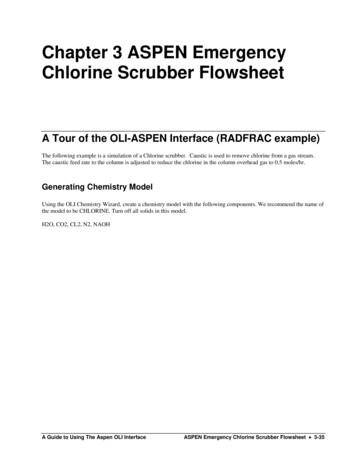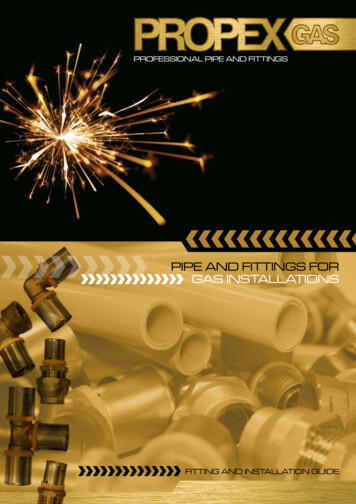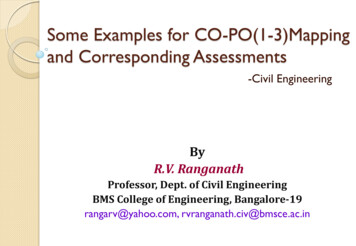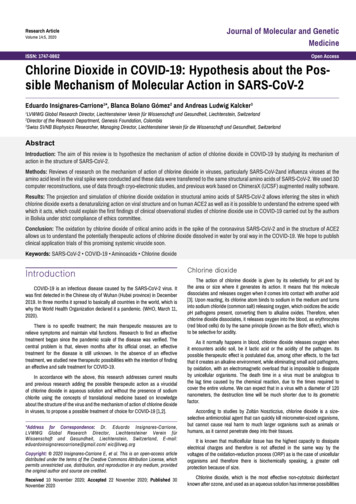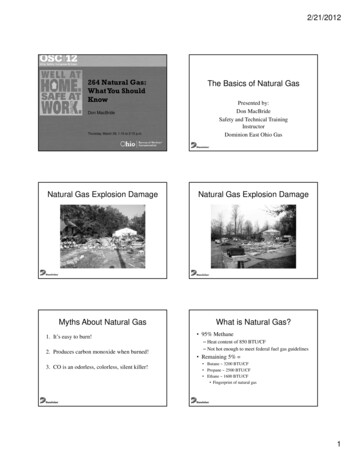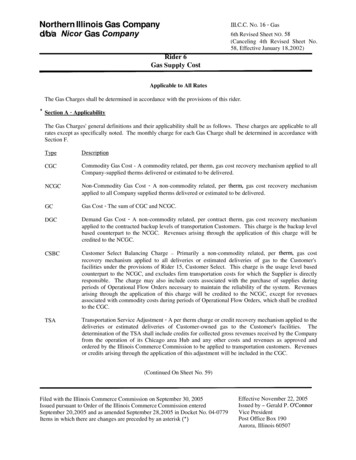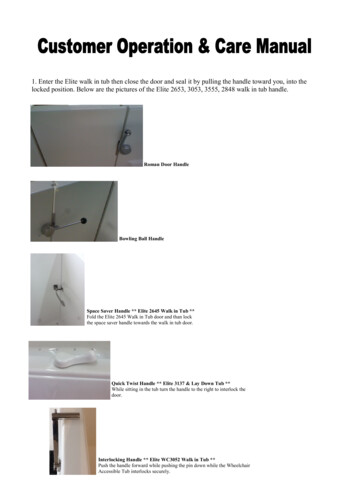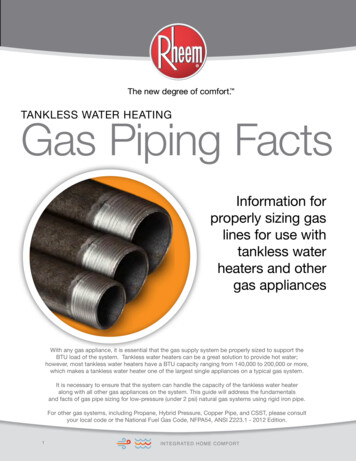
Transcription
May 2010DOH 331-364How to Handle Chlorine Gas SafelyExposure to chlorine is irritating to the eyes, nose, throat, and mucous membranes. At highlevels, exposure could cause serious injury or death.Chlorine gas is greenish-yellow and smells like bleach. It is highly corrosive and reacts violentlywith petroleum products such as gasoline, diesel, oil, solvents, and turpentine. Chlorine can alsoreact with carbon monoxide and other combustionproducts to make highly toxic and corrosive gases.Chlorine gas weighs about 2.5 times more than airand will settle in low-lying areas unless there issufficient wind to disperse it.Despite these hazards, proper training can helpreduce the risk for those who handle it. Thispublication is not a substitute for formal training. Itdoes discuss chlorine handling and safety practices,especially for small water systems.Emergency HelpMake a list of all relevant contact numbers and keep it posted at several locations in the plant andoffice (See page 4). Be sure to include the fire department that will respond to your facility,police department, county emergency management office, and your Department of Health Officeof Drinking Water regional office. This list will be particularly important if you don’t have 9-1-1service in your area. Keep the numbers updated.Inform local police and fire departments about the chemicals used in your plant, especiallychlorine, so they can be prepared if an emergency occurs. You should organize escape plansfrom areas where there might be a chlorine release. Taking short cuts could be deadly.Protective equipment for water systems that use chlorine gasRespiratory equipment where employees handle chlorine: Your equipment should meetNational Institute for Occupational Safety and Health requirements. It should use compressed air,have at least a 30-minute capacity, and be: Available where employees handle chlorine gas. Kept in a convenient location, but not inside any room where chlorine is used or stored. Compatible with—or identical to—the units your fire department uses. Tested and refilled regularly. Ask your fire department to inspect and test the unit(s).1
Other equipment: Each operator should have rubber gloves, a protective apron or other protective clothing,and goggles or a facemask. A deluge shower and eye washing station where operators use or store strong acids oralkalis. Provide warm water for the shower.The Buddy SystemIt’s wise to have a second person present when you change or handle chlorine. If one operator isincapacitated, the other can call for help. Do not work alone!Separate Chlorine RoomIt’s important to have a separate room for chlorine gas. Check with local building officials, thefire marshal, and the Chlorine Institute about safe storage and use requirements for chlorine.The chlorine storage and feed rooms should be:; Enclosed, sealed, and separated from other operating areas.; On the downwind side of the building, away from entrances, windows, louvers, walkways,and other occupied areas.; At least 60 F, but protected from extreme heat or direct sunlight.The room should have:; A shatter-resistant inspection window mounted in an interior wall of the plant.; Doors equipped with panic hardware that provide an easy escape by opening outward to thebuilding exterior.; A ventilating fan that exchanges the air at least once a minute. Run the fan whenever theroom is occupied.; An air intake near the ceiling and an exhaust near the floor. Make sure the fan exhaustsoutdoors and moves air as far as possible away from doors, air inlets, or occupied areas.; Motorized louvers that provide airtight closure.; Individual vandal-proof switches for the fan and lights located both outside the chlorineroom and at the inspection window. Provide signal lights if you can control the fan frommore than one location.; A nonslip floor. Floor drains are a bad idea. If your chlorine room does have a floor drain,seal it or make sure it discharges outdoors away from air inlets, doors, or occupied areas.The drain should not connect to other internal or external drainage systems.Chlorine Leak DetectionThe chlorine room should have continuous leak-detectionequipment with audible and visual alarms employeesthroughout the treatment plant can see and hear. Follow themanufacturer’s recommendation for calibrating and testingthe equipment. Record your findings.You can use a rag soaked in concentrated ammoniasolution to locate gas leaks at fittings and pipe connections.A white cloud or vapor indicates a leak.Make sure workers have a Chlorine Institute-approved leak repair kit (Kit A for cylinders andKit B for containers).-2-
Safety Tips for 100- and 150-Pound Cylinders and Ton Containers Take shallow breaths in the chlorine roomuntil you are sure there is no chlorine leak.Never lift a cylinder by its hood.Always keep the hood in place, exceptwhen the cylinder is in use.Never expose a cylinder to heat or directsunlight.Never drop a cylinder, or knock a cylinderover.Always keep empty cylinders separatefrom full ones.Always secure empty and full cylinderswith a cable or chain. Never tamper with a fusible plug.Never store chlorine with ammonia.Don’t move full ton containers withequipment designed to handle less than twotons.Don’t connect liquid valves of two or morecontainers to a common manifold.Never store combustible or flammablematerials near chlorine containers.Never attempt to weld an “empty” chlorinepipeline without purging it with air.Don’t spray water on a leaking container. Itwill make the leak worse.Changing 100- and 150-Pound Cylinders1. Turn valve stem clockwise to close cylinder valve.2. Allow float in flow meter to drop to zero. Indicator on frontof gas feeder should indicate no gas.3. Wait about one minute. Float should remain at zero. If thefloat flutters or does not drop to zero, the valve is not closedtightly. Make sure the valve is closed before proceeding.4. Turn off ejector, and make certain the gas supply indicatorstays in the “No Gas” position by turning the “Reset” knob.If the indicator resets, either gas pressure is still present orthere is an air leak in the system. Refer to instructionmanual if an air leak is evident.5. Loosen gas feeder yoke screw. Remove gas feeder fromvalve.6. Replace gas cylinder. Be sure to use a chain or cable tosecure the new cylinder properly.7. Remove old lead gasket. Inspect and clean mating surfacesof gas feeder and valve. Install new lead gasket.8. Position gas feeder on new gas cylinder and tighten yokescrew. Do not tighten excessively.9. Crack open gas cylinder valve and close quickly.10. Use ammonia solution to check for leaks. If a white cloudor vapor appears, turn on ejector and repeat steps 2, 3, 4,and correct leaks.11. After you verify there are no leaks, open gas cylinder valve,about ¼-turn only, and leave cylinder wrench on valve.12. Turn on the ejector.Notes: A. See your gas feeder manufacturer’s guide for more detailed instructions.B. Immediately contact your gas supplier if the cylinder valve or cylinder is defective.-3-
Chlorine Reporting Requirements100 pounds or more: The Emergency Planning and Community Right-to-Know Act requiresfacilities that store 100 pounds or more of chlorine to report to the Washington State EmergencyResponse Commission and local agencies. The U. S. Environmental Protection Agency (EPA)may take action against facilities that fail to report. The Department of Ecology represents theState Emergency Response Commission. Reporting requirements, forms, and software are onlineat http://www.ecy.wa.gov/epcra/1,500 pounds or more: The federal Occupational Safety and Health Administration (OSHA)and, in Washington, the state Department of Labor and Industries regulate chlorine quantities of1,500 pounds or more. For requirements in Washington, call (360) 902-5478.2,500 pounds or more: EPA regulates chlorine quantities of 2,500 pounds or more.Emergency NumbersChlorine First AidPost relevant contact numbers at severallocations in the plant and office. Keep themup to date.Inhalation Remove victim from contaminated area. Keep victim warm, in a reclining positionwith head and shoulders elevated. Give artificial respiration, if necessary. Administer oxygen as soon as possible. Call a physician immediately.Fire:Police:Skin Contact Shower victim, removing all contaminatedclothing. Wash affected area with soap and water.County EmergencyManagement Office:Eye Contact Irrigate eyes with water for 15 minutes,holding eyelids wide apart. Call a physician immediately. Irrigate a second 15-minute period ifphysician is not immediately available.Department of HealthOffice of Drinking Water:Health Effects Low concentrations: Burning eyes, noseand throat; redness in the face; sneezingand coughing. High concentrations: Tightness in thethroat and difficulty breathing. 1,000 parts per million (ppm) is fatal aftera few breaths. Even an hour later, 35-51 ppm can befatal.Eastern Region, Spokane(509) 329-2100Northwest Region, Kent(253) 395-6750Southwest Region, Tumwater(360) 236-3030-4-
Changing Ton Cylinders1. Turn the valve stem clockwise to close ton container valve.2. Allow float in flow meter to drop to zero. Indicator on front of gas feeder should show redindicating no gas. All liquid must be vaporized from the trap.3. Wait about one minute. Float should remain at zero. If float flutters or does not drop to zero,valve may not be closed tightly. Make certain valve is closed before proceeding.4. Turn off ejector and make certain the gas supply indicator stays in the “No Gas” position byturning the “Reset” knob. If the indicator resets, either gas pressure is still present or there isan air leak in the system. Refer to instruction manual if an air leak is evident.5. Loosen gas feeder yoke screw. Remove gas feeder from valve.6. Replace ton container. Make sure the full container is oriented with the valves in the verticalposition, one valve above the other. The top valve will always supply gas chlorine and thebottom valve will give liquid chlorine.7. Remove old lead gasket. Inspect and clean mating surfaces of gas feeder and valve. Installnew unused lead gasket.8. Position gas feeder on new gas cylinder and tighten yoke screw. Do not tighten excessively.9. Be sure heater is plugged in and operating. An operating heater provides heat to vaporize anytrapped liquid.10. Crack open gas cylinder valve and reclose quickly. Check for leaks. If leaks exist, turn onejector and repeat steps 2, 3, 4, and correct leaks.11. Leak test solutions: Chlorinator/Sulfonator- Ammonia: Ammoniator-Bleach.12. Open ton container valve slowly about ¼-turn only and leave cylinder wrench on valve.13. Turn on ejector.Notes:A. Refer to gas feeder instructions bulletin for more gasket detailed instructions.B. Contact your gas supplier if the cylinder valve or cylinder is considered to be defective.-5-
For more informationThe Chlorine Institute Get information on safe chlorine handling online athttp://www.chlorineinstitute.org/ (Go to bookstore and click on “Free titles about chlorinepackaging” in the right column). The Chlorine Institute, Inc., Headquarters Office, 1300 WilsonBlvd., Arlington, VA 22209. Phone (703)741-5760 Fax (703)741-6068National Institute for Occupational Safety and Health (NIOSH) Find chlorine resourcesonline at http://www.cdc.gov/niosh/topics/chlorine/ NIOSH, Centers for Disease Control andPrevention, 1600 Clifton Rd., Atlanta, GA 30333. Phone (800) CDC-INFO (800-232-4636),TTY: (888) 232-6348, 24-hours a day, e-mail cdcinfo@cdc.govOccupational Safety and Health Administration (OSHA) Find OSHA’s guide to chlorineonline at /recognition.html OSHA, 200Constitution Avenue, NW, Washington, DC 20210Recommended Standards for Water Works: Ten State Standards Published by HealthResearch Inc., Health Education Services Division, P.O. Box 7126, Albany, NY 12224. Toorder, call (518) 439-7286 or visit the Web site at http://www.hes.org/HES/ten.htmlSpecial RecognitionParts of this document were adapted with permission from an article that appeared in the fall2006 On Tap newsletter, published by the National Environmental Services Center. ZaneSatterfield, P. E., NESC engineering scientist, was the original author, and James Bouquot wasthe original graphic designer.-6-
Safety Tips for 100- and 150-Pound Cylinders and Ton Containers Take shallow breaths in the chlorine room until you are sure there is no chlorine leak. Never lift a cylinder by its hood. Always keep the hood in place, except when the cylinder is in use. Never expose a cylinder to heat or direct sunlight.
